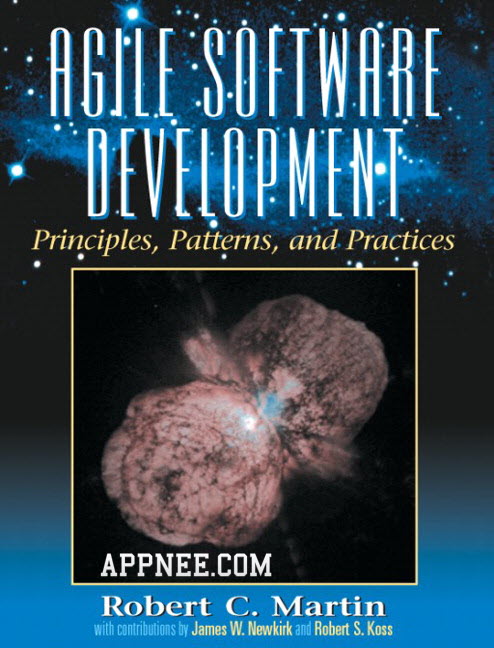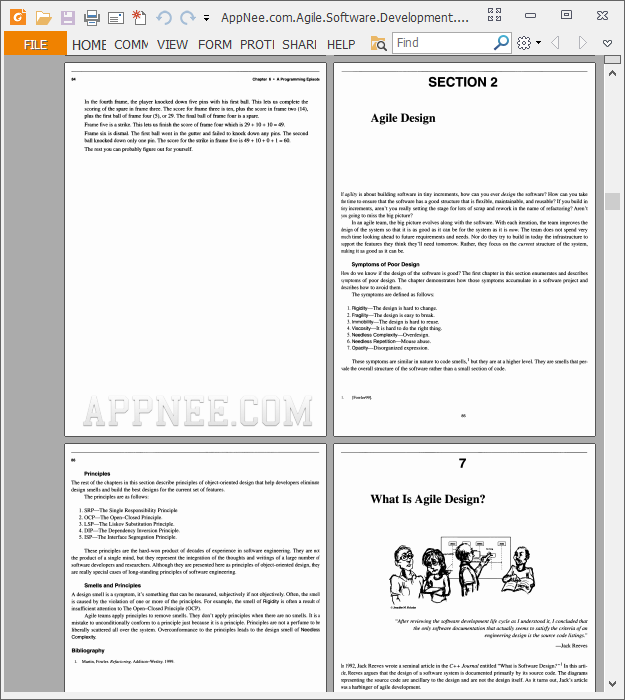
In Agile Software Development: Principles, Patterns, and Practices (ASDP: 3P for short), the world-famous software development expert and software engineering master Robert Cecil Martin (AKA: Uncle Bob) will show you how to solve the most tricky problems software developers, project managers and project leaders are facing. Again, this comprehensive and practical guide for agile software development and extreme programming has the credit from the founders of agile development.
In AppNee's opinion, the standards of well-written technical books include: easy to understand; refined words; durably informative; attractive; full of thoughtful ideas, etc. Agile Software Development's less than 600 pages of content is divided into 6 parts & 4 appendices. Each part explains the profound knowledge in simple terms, humor language along with vivid examples. This richly shows the writer's extraordinary writing ability, not to mention his technical cultivation with no doubts. You may not have thought that a technician could write a book so well that it can be regarded as a model for all kinds of teaching materials' authors.

Limited to my poor ability of language expression, it's hard for me to use the most accurate words to describe this book, just hope every student/staff studying/studies the computer related majors to give it a read, you will never regret it. BTW, it is pretty difficult to get Agile Software Development's eBook resource in English, I believe you've known this! So do cherish it and share it to more guys who are finding it in any way you like.
Table Of Contents
- I. AGILE DEVELOPMENT
- 1. Agile Practices.
- 2. Overview of Extreme Programming.
- 3. Planning.
- 4. Testing.
- 5. Refactoring.
- 6. A Programming Episode.
- II. AGILE DESIGN
- 7. What Is Agile Design?
- 8. SRP: The Single-Responsibility Principle.
- 9. OCP: The Open-Closed Principle.
- 10. LSP: The Liskov Substitution Principle.
- 11. DIP: The Dependency-Inversion Principle.
- 12. ISP: The Interface-Segregation Principle.
- III. THE PAYROLL CASE STUDY
- 13. Command and Active Object.
- 14. Template Method & Strategy: Inheritance vs. Delegation.
- 15. Facade and Mediator.
- 16. Singleton and Monostate.
- 17. Null Object.
- 18. The Payroll Case Study: Iteration One Begins.
- 19. The Payroll Case Study: Implementation.
- IV. PACKAGING THE PAYROLL SYSTEM
- 20. Principles of Package Design.
- 21. Factory.
- 22. The Payroll Case Study (Part 2).
- V. THE WEATHER STATION CASE STUDY
- 23. Composite.
- 24. Observer—Backing into a Pattern.
- 25. Abstract Server, Adapter, and Bridge.
- 26. Proxy and Stairway to Heaven: Managing Third Party APIs.
- 27. Case Study: Weather Station.
- VI. THE ETS CASE STUDY
- 28. Visitor.
- 29. State.
- 30. The ETS Framework.
- Appendix A. UML Notation I: The CGI Example
- Appendix B. UML Notation II: The Statmux
- Appendix C. A Satire of Two Companies
- Appendix D. The Source Code Is the Design
Download URLs
 (41.8 MB | Homepage)
(41.8 MB | Homepage)